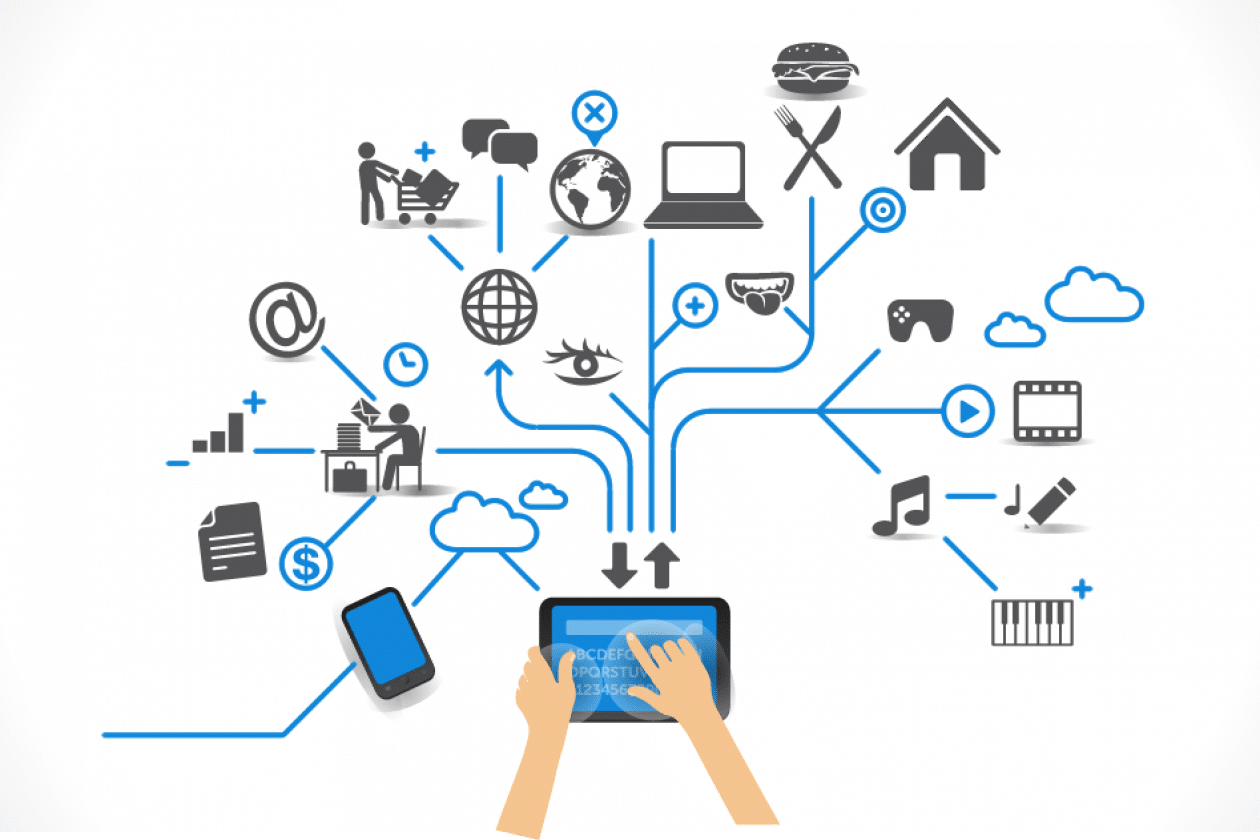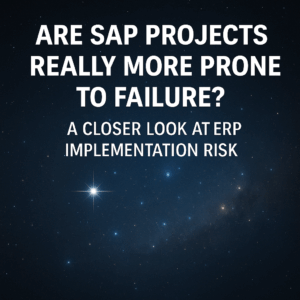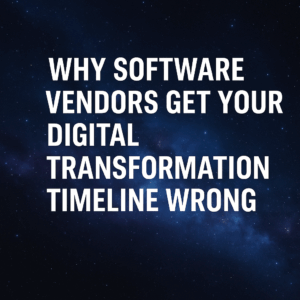If you’re about to start a transformation, it’s time to call a timeout. There are a few key things that you need to get done before you start your business transformation. One of the common phenomena we see with organizations going through transformations is they define a digital strategy, they select the software, and jump in and start implementing stuff.
Why could this be a bad decision?…
Establishing the direction and the start of the actual implementation usually ends up too compressed, and organizations being software implementation before they’re ready. Companies end up spending too much time and money, and in the end, get off course because of a lack of clearly defined needs, roadmap, plan, etc.
Before you hit the gas, look at these handfuls of things that you need to do before you begin your transformation. For your digital transformation to be successful, proper pre-planning is a must. Clearly defining your requirements and creating a transformation roadmap is critical to the process.
Table of Contents
ToggleImplementation Planning
When you get proposals from your vendors that include a proposed project plan, there are two problems you need to look for:
- It’s usually overly optimistic as far as how long it’s going to take, and how many resources it’s going to require.
- It’s usually incomplete. It doesn’t include all the non-vendor, non-software-specific things that need to happen during a transformation.
Things like organizational change management, process improvements, data migration, data mapping, and integration to other systems all need to be accounted for and factored into your implementation plan.
In many cases, these considerations are actually what drive your overall time and cost. When you get your input from your software vendor, consider just one input, one piece of your complete implementation plan. Don’t base your entire implementation on that one plan because it’s just one workstream within the overall plan.
That’s one of the first things you want to do is make sure you have a very clear implementation plan that focuses on establishing a very solid foundation before you begin the technical implementation.

Future State Through Business Processes
The next thing that needs to happen before you begin your implementation is to define your future state business processes. A lot of organizations intuitively think that we should just wait until we implement the software, let the vendor come in, and in the end, let the technology dictate how we’re going to up our business processes.
There are a couple of problems here:
- Today’s ERP systems are so flexible in general that they can handle simple or even the most basic workflows in a multitude of different ways. If you don’t have the answer or the direction of how you want the software to work, you’re going to be spinning your wheels trying to make decisions while the meter’s running on all the expensive technical consultants.
- Focus on defining your macro business processes because it is critical that you identify the unique differentiators for you. Things that are unique to your business model, and most importantly, your competitive edge.
You want to define those processes and what you want that future state to look like so that you can craft a clear strategy for the software vendor, rather than assuming that the software vendor will tell you how to run your business.
Now, there’s going to be certain parts of your business, like accounts payable or general ledger that are more or basic or vanilla in nature, and chances are, you might be able to settle for whatever the software does in those areas.

When it comes to the customer experience and unique differentiators for how you provide superior services or products to your customers, you want to focus a lot of time on making sure you define those upfronts so that you have a clear blueprint for how you’re going to away at the technology later on.
Future State Overall
Just as you need to define your future state business processes, you also need to define what your future state organization. If you’re going to consolidate your procurement department, for example, or you’re going to move to a shared service HR model within accounting and finance, you want to define what that all looks like, and ask how are you going to be organized?
The answer is not all that simple…
You need to ask yourself what roles and responsibilities are going to look like so that you can involve those people affected by those changes. You can include them in the transformation, and so you have a clear vision for how you’re going to deploy the technology, so that you’re not spinning your wheels.
In the end, if you have that clear vision of what the organization’s going to look like on the other side, that’s going to give you a lot more clarity, efficiency, and effectiveness to how you deploy new technology.

Create Your Technical Roadmap
It’s often assumed that a digital transformation is going to consist of one single ERP system that’s going to do everything for us. It’s very rare that that ever truly materializes. Most organizations, even if they find that an ERP system does 80 – 90% of what they need it to do. They’re still going to have other bolt-on systems, other technologies they need to integrate to for regulatory reasons, or because there are weaknesses in the ERP system.
Every ERP system out there has weaknesses that you’ll need to address. Oftentimes, the way to that is through bolt-on systems. First, you need to define what that feature state technology and roadmap is.
Let’s remember, it’s not just the enterprise technologies you have to think about. You also must think about how we’re going to interface to other non-enterprise technologies.
For example, if there’s email approvals or things that you’re going to do in SharePoint outside the system, and it’s going to somehow integrate back to your ERP system, those are just two small examples of how you’d want to make sure you have a clear roadmap from a technology perspective of how all these pieces are going to fit together.
Most organizations simply don’t find that one single solution is going to solve all their problems. Typically, it’s a multitude of different technologies and tools, and you need a clear roadmap for how to tie that all together.
Organizational Change Strategy
One of the biggest indicators of how long your project is going to take, how much it’s going to cost, and how painful it’s going to be is… how you address organizational change management.
In other words, organizational change management is typically going to be on your critical path for your implementation. When you’re building out your implementation plan, and when you’re in this implementation readiness phase. You’ve selected software and now you want to define what that organizational change strategy is.
It all begins with two things:
- Organizational Assessment: An understanding and analysis of your business. This should be an organizational benchmark to other cultures and other organizations so that you can identify where those pockets of resistance are likely to come from.
- Change Impact: How is it the jobs are going to be impacted? How is it that the future state organization is going to look and how are we going to get there? What’s the plan? How are we going to migrate to that? All that stuff should be incorporated into your overall implementation plan and strategy.

The more effectively you handle organizational change management and the more time and money you spend on change management. It’s more than likely going to reduce your cost, overall implementation duration, and risk.
Establish Project Governance and Controls
It’s important to go into these projects with a mindset that you oversee this project. You, the implementing organization are responsible for managing the system integrator and the vendors. Therefore, you need to have your own PMO, your own project governance, and controls established.
You can’t just rely on a software vendor to provide governance and controls, partly because that’s not their specialty, but also because, again, they’re just one part of the overall transformation.
You need more of a program governance controls to manage not just the technology, but some of the other pieces that we’ve talked about above. Change management, process improvement, functional architecture, integration, and data migration are all important to keep track of before the digital transformation process.
All of that needs to be managed underneath an umbrella of project governance and controls. The better job you can do establishing those governance controls upfront, it’s going to give you more ownership, more control, and more buy-in into the overall project. It’s also going to make it a lot less likely that the software vendors are going to come in and hijack the project and run it for you.
In the end, it’s going to allow you to be in the driver’s seat and let the software vendor take more of a support role.
These are just a few of the important things that you need to make sure you have in place prior to beginning your transformation. We like to commonly refer to this at Third Stage as the implementation readiness phase.
This is the phase from the time you’ve decided what your technical roadmaps going to be until you actually start the implementation. Most organizations just jump straight into the implementation, and they don’t have a gap there.
What I’m ultimately suggesting here is that it’s very important that you take one step back to be able to take two steps forward. That one step back is to take the time to get that implementation readiness in place to get that solid foundation of blueprint in place so that you can be successful in your transformation.
In Conclusion
If you are interested in learning more about digital transformation, please go check out our 2021 Digital Transformation Report, which includes best practices for transformation, as well as some of the independent software reviews and top 10 rankings that we do every year. I encourage you to check out some of those resources to help you through your transformation.
If you have questions regarding implementation readiness or any other phase of your transformation, feel free to reach out to me directly. I’d be happy to be an informal sounding board for you and your team.






